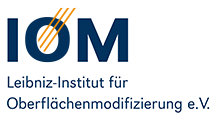C. Eichhorn, F. Scholze, C. Bundesmann, D. Spemann, H. Neumann, H. Leiter
Journal of Propulsion and Power 35 (2019) 1175
https://doi.org/10.2514/1.B37487
Gridded ion engines apply an electrically biased extraction grid system in order to accelerate ionized particles, which, in this way, form the „propellant“ of the device. An intact grid geometry, in particular the preservation of the grid hole diameters, is a basic requirement with regard to the long-life cycle of such thrusters used in spaceflight applications. The knowledge of spatially resolved densities of plasma species near the thruster exit plane is important for a quantitative estimation of plasma- and surface processes that may lead to undesirable grid hole widening (grid hole erosion). This work demonstrates how neutral particle densities of a relevant propellant (krypton) can be experimentally measured during thruster operation using non-intrusive techniques based on laser spectroscopy.
C. Bundesmann, C. Eichhorn, F. Scholze et al.
Eur. Phys. J. D 70 (2016) 212
https://doi.org/10.1140/epjd/e2016-70236-0
Experimental characterization is an essential task in the development, optimization and qualification process of electric propulsion thrusters or ion beam sources, because it allows verifying that the thruster or ion beam source fulfills the requested mission or application requirements. Furthermore, it can provide parameters required for thruster and plasma modeling. In addition, there is a need for standardizing electric propulsion thruster diagnostics in order to make characterization results of different thrusters as well as measurements performed in different vacuum facilities reliable and comparable. Therefore, an advanced electric propulsion diagnostic (AEPD) platform was developed that allows a comprehensive in-situ characterization of electric propulsion thrusters (or ion beam sources) and could serve as a standard on-ground diagnostic tool in the future. The AEPD platform uses a five-axis positioning system and provides the option to use diagnostic tools for beam characterization (Faraday probe, retarding potential analyzer, ExB probe, active thermal probe), for optical inspection (telemicroscope, triangular laser head), and for thermal characterization (pyrometer, thermocamera). Here, the capabilities of the diagnostic platform are described and first experimental results of the characterization of a gridded ion thruster RIT-μX are shown.
M. Rudolph, H. Hajihoseini, M. A. Raadu, J. T. Gudmundsson, N. Brenning, T. M. Minea, A. Anders, D. Lundin
J. Appl. Phys. 129 (2021) 033303
https://doi.org/10.1063/5.0036902
The internal discharge parameters, the probabilities of target atom ionization and target ion back-attraction, are two important parameters for understanding high power impulse magnetron sputter processes. The work gives a description of how to obtain these parameters from experiments. Using this method HiPIMS processes can be optimized in an efficient way.
S. Germer, F. Pietag, J. Polak, T. Arnold
Rev. Sci. Instrum. 87 (2016) 113301
https://doi.org/10.1063/1.4964701
The ion beam etching of insulating materials typically requires using a neutralized ion beam to avoid up-charging. Under these conditions, the measurement of the ion beam density distribution via Faraday probes is hampered. Such electrical measurements may also be affected by charge exchange processes that result in the production of fast neutral atoms which contribute to ion beam etching but cannot be detected by charge-sensitive measurements. In this study, single crystal YAG:Ce (Y3Al5O12) scintillators monitored by a CCD camera were used to image the energy deposition of a neutralized low-current ion beam from a broad beam ion source via the scintillation light. To validate the presented beam diagnostic tool, Faraday cup measurements and test etchings were performed. Argon ions with a typical energy of 1.0 keV were emitted from an inductively coupled radio-frequency (13.56 MHz) ion beam source with total currents of some mA. Different beam properties, such as, lateral ion current density, beam divergence angle, and current density in pulsed ion beams have been studied to obtain information about the spatial beam profile and the material removal rate distribution. We observed excellent imaging properties with the scintillation screen and achieved a detailed characterization of the neutralized ion beam. A strong correlation between the scintillator light output, the ion current density, and the material removal rate could be observed.
L. Pietzonka, C. Eichhorn, F. Scholze, D. Spemann
J. Electr. Propuls. 2 (2023) 4
https://doi.org/10.1007/s44205-022-00029-4
In diesem Beitrag wird die Anwendung der laserinduzierten Fluoreszenzspektroskopie (LIF-Spektroskopie) im Zentralbereich der Entladungskammer einer mit Xenon betriebenen Radiofrequenz-Breitstrahlionenquelle beschrieben. Hierbei wurden zwei optische Übergange von Schwerteilchenspezies (Atome und einfach geladene Ionen) eines Xenonplasmas im nahen Infrarot bei sehr hoher spektraler Auflösung unter Zuhilfenahme eines durchstimmbaren Diodenlasers mit schmaler Linienbreite untersucht.
Die Bewegung von Teilchen der jeweiligen Plasmaspezies relativ zur Richtung des Laserstrahls induziert aufgrund des Doppler-Effekts eine Verschiebung der individuellen Resonanzfrequenzen und zeigt sich in Form einer spektralen Linienverbreiterung. Unter Berücksichtigung zusätzlich auftretender Linienverbreitungsmechanismen können daher die projizierten Verteilungsfunktionen der Neutralteilchen- und Ionengeschwindigkeiten optisch und somit nicht-intrusiv rekonstruiert werden. Die Breite der Geschwindigkeitsverteilungsfunktionen ist mit der kinetischen Temperatur der jeweiligen Plasmaspezies verknüpft; es konnte gezeigt werden, dass dieser Parameter in beiden Fällen mit der Stärke des in die Entladung eingekoppelten Radiofrequenz-Wechselfeldes korreliert ist.
Die experimentelle Untersuchung von Plasmaschwerteilchenspezies hinsichtlich ihrer kinetischen Temperatur ist ein wesentlicher Baustein für die simulationsbasierte Abschätzung der Leistungsfähigkeit von elektrischen Raumantrieben und der Lebensdauervorhersage für Triebwerkskomponenten. Damit stellt der hier vorgestellte Versuchsaufbau zur LIF-Spektroskopie eine Erweiterung der kooperativ entwickelten Advanced Electric Propulsion Diagnostic (AEPD)-Plattform zur In-Situ-Charakterisierung von Ionentriebwerken dar.
